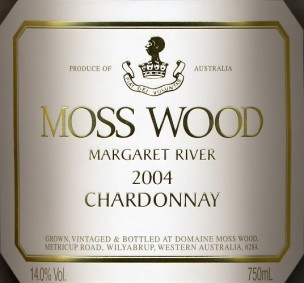Moss Wood 2004 Chardonnay
Wine Facts
| Harvested: | 22/2/2004 |
| Bottled: | 15/6/2004 |
| Released: | 10/5/2005 |
| Yield: | 3.05 t/ha |
| Baume: | 12.99 |
| Alcohol: | 14.00% |
| Vintage Rating: | 9/10 |
SOLD OUT
Moss Wood 2023 Chardonnay – Rob Geddes MW
This wine was included in the 2025 Masters of Wine exam which means it is regarded by them as a classic example of the regional varietal style, so I was excited having the chance to taste it among a wide array of Margaret River Chardonnay with both the “classic” concept…
Tasting Notes
The Moss Wood 2004 Chardonnay has a complex nose showing lime and grapefruit citrus aromas, hints of roast cashew, some caramel from the malolactic fermentation and light spicy oak. It’s flavoursome and lively, deep and long, with white peach and nectarine characters adding flesh to the mid-palate. It’s tighter, leaner and more restrained at this stage but clearly focused with underlying power, persistence and a clear, bright finish that refreshes.
Vintage Notes
The 2004 Chardonnay yields were slightly above average. The vintage was a good one, especially for the early ripening varieties such as chardonnay. For the first time, there was no destemming and the grapes were whole bunch pressed. The juice was settled after pressing for 48 hours, pumped into stainless steel tanks with 2% solids, then seeded for fermentation. After fermentation, it was transferred into 100% new French oak barrels with daily battonage (stirring) until dryness.
Production Notes
The latest vintage of Moss Wood Chardonnay is best understood in the light of developments at the winery since the 2000 vintage. With the 2000 and 2001 Moss Wood Chardonnays, the prime focus (apart from making good wine) was on resolving random oxidation problems which have afflicted many white wine producers and some Moss Wood Chardonnays from 1992 onwards. To do this, we revisited the composition of the Chardonnay in an attempt to find ways of promoting flavour ripeness at lower sugar levels. We are seeking to achieve lower levels of alcohol and higher levels of natural acidity in an attempt to further preserve the freshness of the wine. From 2002 onwards, experimentation has been carried out in the vineyard to aggressively increase the levels of fruit exposure. This is done by hand after flowering and before veraison and is possible because of the Scott Henry trellising. Every second row now has its bunches fully exposed, enabling us to pick the grapes slightly earlier than usual (at lower sugar levels) without any signs of greenness in the fruit.
The impact of this work is seen in both the 2003 and 2004 Chardonnays, where the levels of alcohol are between 13.5 and 14%, rather than the 14.5% seen in previous vintages. The style has changed slightly: acidity levels are a little higher and pH a touch lower. In flavour terms, what used to be ripe melon and peach has become white peach and nectarine, with hints of grapefruit and lime. The aim is to make more tightly structured, steelier whites that have more savouriness and minerality, and are less supple than before - wines that may age much better in the way of the best whites of Burgundy.
Because the wines have lower alcohol levels than before, we have found that they go through malolactic fermentation much more easily and so about half the batches go right through - a big step forward. Importantly, they do this without getting overt, or dominant, malo characters which are further ameliorated by the time spent on lees in barrel.
Trials were conducted into the effects of different levels of fruit exposure, with the trial batches fermented separately. The batches were tasted and the results taken into account during preparation of the vineyard for the 2005 vintage.
After nine months in barrel, the wine was racked into a blending tank where it was cold stabilised, fined and filtered before being bottled at the end of February 2005. 71% were sealed with screw cap and 29% with cork, under the assumption that most of the cork stock will be used for export.
Cellaring Notes
This wine will fill out and appear even more approachable with cellaring and should be at its best after ten years.


